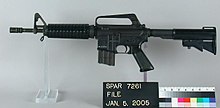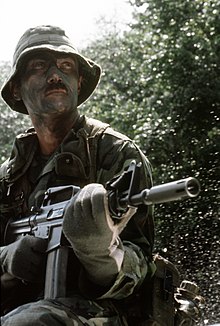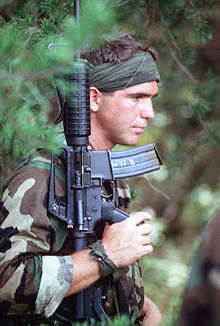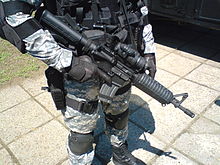Model 2 Sales M16 Commando Upper Half Review

U.S. Navy SEAL with Colt Commando. Note: large flash hider
The Colt Automatic Burglarize-15 or Automobile-15 is a family of M16 rifle–based firearms marketed past Colt in the 1960s and early 1970s. However, the term "Motorcar-15" is most commonly associated with the Filly Commando (AKA: XM177); these select-burn carbines accept ultrashort 10.5-inch (270 mm) and 11.5-inch (290 mm) barrels with over-sized flash suppressors.
The Machine-fifteen name was an attempt to re-associate the AR-15 name with Filly, since the AR initially stood for ArmaLite, the original manufacturer of the ArmaLite AR-15. Colt afterward abased the Auto-15 concept, but connected to brand carbine variations, using the "M16" brand for select-fire models and the "Filly AR-xv" brand for semi-automatic models. All the same, in nowadays usage, "CAR-15" is the generic name for all carbine-length variants made earlier the M4 carbine.
History [edit]

The U.South. Army Ranger in the foreground is armed with an M16A1 carbine (Model 653).
Starting in 1965, Filly attempted to market the M16 rifle as a Modular Weapon System. Past using diverse upper assemblies, buttstocks, and pistol grips, the weapon could be configured as assail rifles, carbines, submachine guns, open-commodities squad automatic weapons and a survival burglarize version. Belt-fed low-cal machine guns were also developed under the Machine-fifteen banner, although they take trivial in mutual with the M16 burglarize. All the same, the U.S. war machine only made pregnant purchases of the Rifle and Commando versions, so Colt abandoned the CAR-15 family concept. The "Car-xv Burglarize" was already identified by most users as the M16 rifle, and "CAR-15" was similarly associated with the short-barreled Colt Submachine Gun and Commando models. Because of that, the term "CAR-xv" has been used to describe whatsoever M16-based carbine, even if the item weapon is not officially named thus.
Colt Automated Burglarize-15 family unit [edit]
Car-15 Rifle (AKA: M16 rifle) [edit]

The Model 603 Motorcar-15 Rifle, adopted initially by the U.s. Ground forces as the XM16E1 and so later as the M16A1, and the Model 604 CAR-15 Rifle, adopted by the The states Air Force every bit the M16, formed the core of the Automobile-15 family unit. However, the United States military had already committed to purchases before Colt created the concept of the Car-fifteen weapons arrangement. The main deviation between the Model 603 and Model 604 is that the onetime has a forward assist, allowing a user to manually close a stuck bolt.
Auto-fifteen Heavy Assault Rifle M1 [edit]
The CAR-fifteen Heavy Assault Burglarize M1 was a heavy-barreled version of the standard AR-15 with a bipod attachment, intended for use as a Team Automated Weapon (SAW). It was designed to feed from 30-round box magazines.
CAR-fifteen Heavy Assault Rifle M2 [edit]
The Automobile-xv Heavy Assault Burglarize M2 was a belt-fed conversion of the standard CAR-15, with a heavy barrel and bipod attachment. Information technology was made in prototype form only and saw no sales.
CAR-15 Carbine [edit]

A semi-automobile Bushmaster Dissipator barrel which uses a similar brusk-barrel, standard length paw-guard concept to the Car-15 Carbine
The Model 605A CAR-fifteen Carbine was a shortened version for situations where longer weapons could be unwieldy, such every bit aboard vehicles or helicopters. It was an improved version of the AR-15 SBR, which was a shorter barrel version of the Colt Armalite AR-xv. The only significant change from the M16 rifle was that the barrel was shortened to 15 inches (381 mm) in length, so that it concluded just forward of the forepart sight base of operations. Because of the shorter barrel, no bayonet mounting lugs were provided. One image used a shorter handguard and a 16-inch (410 mm) long butt.
The Model 605B had no forrad assist, only had a four-position selector switch (developed by Foster Sturtevant in December 1966) and then that a user could select safe, semi-automatic, three-circular burst, or total automatic modes of fire. Unlike the standard iii-position group, the four-position group went from (going clockwise from the 9 o'clock position) safe, fully automated, semi-automatic and finally outburst. The selector itself had 360 degrees of motion, and could exist moved either clockwise or counterclockwise, unlike with standard groups. Instead of iii-round flare-up, the burst cam could be modified to two-circular or six-round outburst. Both versions used the rifle-length buttstock.
Equally early as 1964, United States Navy SEALs were using the CAR-15 Carbine.[1]
Car-15 Submachine Gun (AKA: CAR-15 Model 607) [edit]

In belatedly 1959, Filly introduced a Tanker Model of the AR-15. Information technology was the get-go AR-xv made with a retractable buttstock, with its overall length being only 26 inches (660 mm) with the buttstock retracted. The retractable buttstock resembled a shortened version of the stock-still buttstock, but a two-position latch recessed in the back allowed it to be extended and locked into position, increasing the length of pull by 2.vii inches (69 mm). The barrel is too brusque to mount a bayonet, so the SMG had no bayonet lug. In 1965, Colt introduces the new Model 607 Automobile-15 Submachine Gun (SMG), which is an improved version of the Colt Armalite AR-15 Tanker Model with some modifications from the M16. It was a meaty weapon for use by special forces and vehicle crewmen. The dictionary definition of submachine gun is an automatic firearm that fires pistol-caliber cartridges. Nonetheless, manufacturers such as Colt, Heckler & Koch, and Zastava Arms accept referred to meaty carbines every bit submachine guns, to emphasize their short length and to differentiate them from longer carbines.
Nearly l Automobile-xv SMGs were made. Most were issued to Navy SEALs and Army Special Forces, though some were as well given to Army K-9 units. Since it never went into full product, CAR-fifteen SMGs were assembled from available spare parts. The get-go models were made with M16 receivers without forward assists and with shortened pistol grips from the Survival Rifle (see below). The later Model 607A was made with XM16E1 receiver with forrad assist and standard pistol grip. The handguard was made from full-length rifle handguard by cut it in one-half and using either the fore or aft pair, subsequently machining the ends to fit the sideslip ring and handguard cap.
Because of the brusk butt, the CAR-15 SMGs suffered from a loud and brilliant muzzle nail, and a number of muzzle devices were developed to reduce this. The SMGs were initially fitted with the standard M16 rifle's "duckbill" or iii-prong flash hiders, which did not convalesce the problem. In September 1966, Colt developed a 3.5-inch (89 mm) long moderator that lessened the noise and muzzle flash, which besides increased the weapon's reliability by increasing the corporeality of back pressure. However, the moderator created its own bug, such every bit heavy diameter fouling and causing tracer bullets to wildly yaw. A 4.25-inch (108 mm) long moderator with six slots and an expansion chamber, which further reduced racket and flash, replaced the previous muzzle device and became standard for the SMG and the Commando serial, but fouling and tracer problems persisted.[2]
Filly Commando (AKA: CAR-fifteen, XM177 & GAU-5) [edit]

A USAF Combat Command Team member with a GAU-v carbine and oversized flash suppressor.

A USAF security policeman aims his Colt Commando during a live-burn sit-in, part of Operation Desert Shield. Notation: big wink hider
The Colt Commando was not initially part of the Auto-15 War machine Weapons System, but was added in 1966 in response to the The states military's desire for a shorter M16 and without the Model 607 SMG's inadequacies. Colt engineer Rob Roy designed a simpler ii-position telescoping tubular aluminum buttstock to supersede the complicated extending triangular version. The fragile and ad hoc triangular handguards were replaced by reinforced round handguards. Each half of the circular handguard is identical, simplifying logistics by not requiring a top/lesser or left/right pair. The Model 609 Commando has a forward assist, while the Model 610 Commando does not. A Model 610B with a four-position selector was available, just not used by the U.South. military. All versions are equipped with the 4.25-inch (108 mm) long moderator.[3]
The XM177 uses a unique flash suppressor sometimes called a wink or sound moderator for its 10-inch (250 mm) barrel. This device is 4.2 inches (110 mm) long and was designed primarily as a counterbalance measure as the shorter butt makes the weapon unwieldy.[4] This device reduces wink signature profoundly and audio signature slightly, making the normally louder curt barreled carbine sound similar a longer barreled M16A1.[five] Although it has no internal baffles and does not completely reduce the audio signature to subsonic levels, because it alters the sound level of the weapon, the US Bureau of Alcohol Tobacco Firearms and Explosives has declared this muzzle device to be a sound suppressor and regulates its civilian purchase in the United States.[five]
The Model 610 was classified as the XM177 [half-dozen] but adopted by the Air Force as the GAU-five/A Submachine Gun (GA cogent an automatic gun and U a complete unit rather than a parts kit: the popular "gun shipping unit" and "gun automatic unit" explanations are backronyms[seven]). The Regular army purchased 2,815 Model 609 CAR-15 Commandos on June 28, 1966, which were officially designated Submachine Gun, five.56 mm, XM177E1.[6] As part of the contract, Colt was supposed to supply each XM177E1s with seven 30-round magazines, only Colt was unable to build a reliable 30-circular curved magazine that would fit in the M16 magazine well, then most XM177E1s were shipped with 20-round magazines. The exception was 5th Special Forces Group, who received a total of four early thirty-round magazines. Filly completed delivery of the purchased XM177E1s in March 1967.
In 1967, in response to field testing, Colt lengthened the Commando'southward barrel from 10 to 11.5 inches (254 to 292 mm). The increased length reduced noise and muzzle wink, and allowed plumbing equipment of the Filly XM148 grenade launcher. A metal boss was added to the moderator for mounting of the XM148 and burglarize grenades.[8] The chambers were chrome-plated. The Commandos with the longer barrels were chosen the Model 629 and Model 649. The Model 629 Commando has a forward assistance; the Model 649 Commando does not.
In April 1967, the Army purchased 510 Model 629 Commandos for use by troops assigned to the Military Aid Command, Vietnam Studies and Observations Grouping (MACV-SOG), and designated them XM177E2.[6] Delivery was completed by the stop of September 1967. The Air Force adopted a similar model without the forward assist characteristic as the GAU-5A/A. Sources debate whether or not this was a Colt Model 630 or Model 649.[6] According to John Plaster and other sources, the lack of 30-round magazines continued to be problematic and SOG operators resorted to pooling their personal resources and purchasing the larger capacity magazines on the civilian U.Southward. marketplace.[nine] Problems with range, accurateness, barrel fouling, and usage of tracer bullets continued to plague the XM177 series, but Colt estimated that information technology would take a six-month $400,000 plan to practise a consummate ballistic and kinematic study. At that place were also recommendations for a 29-month $635,000 enquiry and development program. Both recommendations were declined by the U.S. war machine equally American ground force interest in the Vietnam War was gradually winding down. Production of the CAR-xv Commando ended in 1970.
CAR-15 Survival Rifle [edit]
The Model 608 CAR-15 Survival Burglarize was meant for use by downed aircrew. Because of the Motorcar-15's modular design, the Survival Rifle could be cleaved downwardly into ii subassemblies and stowed with iv 20-circular magazines in a pilot's seat pack. Resembling a Filly Commando, it also has a 10-inch (250 mm) butt and is 29 inches (740 mm) in overall length when assembled. The Survival Rifle used a fixed tubular plastic-coated aluminum buttstock and a round handguard that were not used on the other Motorcar-15 versions, and did not have either a forrad assistance or a bayonet lug. The pistol grip was chopped downwards, and the cage was equipped with either a conical flash hider or the iii.v-inch (89 mm) long moderator.
Postal service-Vietnam [edit]

Later on the Vietnam War, Filly abandoned the Auto-15 Modular Weapon Organisation concept, but continued to develop short butt carbines. These were marketed as "M16s", while the civilian and law-enforcement semi-automated counterparts were marketed as "Colt AR-15s". Although, they were all commonly called CAR-15s.
M16 Carbine (AKA: Machine-15) [edit]
In the early on 1970s, Colt began development of an M16 carbine with a fourteen.5-inch (370 mm) long pencil barrel. The barrel length was compatible with the existing carbine-length gas system and immune for the mounting of a standard M16 bayonet. Despite having a longer butt, information technology's no longer than the Filly Commando, as the longer barrel did not require the long 4.5 inch moderator of the XM177 series, only the much shorter M16 birdcage-type flash hider. Colt labeled the M16 carbines the Model 651, 652, 653, or 654, depending on whether or not it had a fixed or retractable buttstock, or a forward assistance. Only the Model 653 M16A1 carbine, with retractable buttstock and forrad help would be purchased in significant numbers by the U.Due south. armed forces. The Malaysian Military machine and the Armed forces of the Philippines, purchased Model 653s in pocket-size numbers for special operations forces or security forces.
GUU-5/P [edit]

United States Air Force GUU-v/P Carbine
The GUU-5/P was a result of Us Air Force making advertizement-hoc upgrades to its GAU-5 series. The barrels and flash suppressor were replaced with the longer fourteen.v-inch (370 mm) butt with a one-in-12 twist, only the weapons retained their original designations. With the change to M855 cartridges, they either received i-in-seven twist barrel or consummate upper receiver assembly replacements. The GAU-5s markings were also removed and the weapons were re-stamped GUU-v/P.
M4 carbine [edit]

In the early 1980s, at the request of the United States Marine Corps, Colt upgraded the M16A1 burglarize, resulting in the M16A2 rifle. Among the major changes were a reinforced lower receiver, a case deflector, a birdcage flash suppressor redesigned to be a muzzle brake, and a barrel with a faster 1-in-7 twist. The faster barrel was necessitated by the switch from the 55-grain M193 bullet to the 62-grain M855 bullet. The M16A2 burglarize'due south butt was besides thicker for the portion in front end of the handguard. Colt incorporated these changes into its carbines, which it called M16A2 carbines. The Model 723 M16A2 carbine used the iron sights of the M16A1, but had a case deflector. The barrel had a one-in-7 twist, simply the thinner contour of the older M16A1 carbine'due south butt. Equally with the Model 653, the United States armed services fabricated pocket-sized purchases of the Model 723 for its special operation forces.[x] It was notably used by Delta Force operators from the late 1980s to the early 1990s.[11]
In 1983, Diemaco developed a carbine like to the Model 723, the C8 carbine for utilize by the Canadian Forces. The original C8s were congenital past Filly as the Model 725. In 1984, the U.Southward. regime asked Colt to develop a carbine with maximum commonality with the outcome M16A2. Filly named the carbine equally the XM4. The project would eventually culminate in the development and official adoption of the M4 carbine in 1994.
M4 Commando [edit]

Serbian gendarme with a Colt M4 Commando
Though Colt has focused its attention on carbines with xiv.5-inch (370 mm) barrels and rifles with 20-inch (510 mm) barrels, Colt continues to make carbines with 11.5 inches (290 mm) barrels, which it calls Commandos. Originally, Commandos were assembled from whatever spare parts were bachelor, and so Model 733 Commandos could have A1-manner upper receivers with case deflectors or A2-style upper receivers, and M16A1-contour 1:vii or M16A2-profile i:7 barrels. Depending on the specific models, Commandos may take had three-position fire control groups (safe/semi-automatic/three-round flare-up), or four-position having both full-automatic and burst. The modernistic Model 933 has a "flattop" receiver, with a removable carrying handle and a MIL-STD-1913 Picatinny rail, with semi-automatic and automatic burn. The Model 935 Commando has the features of the Model 933, merely has iii-round burst fire instead of automatic. Though originally chosen the M16A2 Commando, Filly at present markets them as the M4 Commando.[12]
The M4 Commando with its short 11.five-inch (290 mm) barrel suffers the same failings as its predecessors: a substantially lower muzzle velocity and greater muzzle wink, in comparing to longer M16 rifles and carbines. The lower cage velocity can reduce carbines' wounding effects.[xiii] However, The states Marine Corps Forcefulness Reconnaissance personnel sometimes used M4 Commandos in place of their M9 pistols.[14] United States Army Special Operations Command Groups as well apply M4 Commandos as self-defence weapons. Usa Navy SEALs use the ultra-compact Mk 18 Modern 0 with its x.3-inch (260 mm) barrel in a similar office.
GAU-5A Aircrew Self Defense Weapon [edit]
In 2019, a solution to give a personal firepower upgrade over the traditional sidearm for The states aircrews in ACES ejection seat–equipped aircraft was to use commercially available AR-15 rifle parts including a special short quick-release butt, collapsible stock, folding pistol-grip, and 4 magazines to fit inside the survival kit pan of the ejection seat. Major Gibson, an Air Strength spokesperson, said, "This has driven the dimension of 16 10 14 ten iii.5 inches." The Aircrew Cocky Defense Weapon is to be included in survival kits for A-10, B-i, B-ii, B-52, F-15C, F-15E, F-xvi, and F-22 aircraft. The rifle is existence built at U.South. Air Force Gunsmith Shop at Articulation Base San Antonio-Lackland, Texas. ii,137 GAU-5A ASDWs are planned.[15] [16]
Gallery [edit]
-

2 1st Cavalry Division Long Range Reconnaissance Patrol teams, Quang Tri, Vietnam, armed in part with CAR-15s, in July 1968.
-

USAF Staff Sergeant with a GAU-5/A converted to a GUU-five/P and fitted with a Blank Firing Adaptor (BFA) for firing blanks.
-
The U.South. Navy SEAL in the foreground is carrying a field radio and is armed with a Colt Model 653 carbine equipped with an M203 grenade launcher.
-

A Malaysian Ground forces operative (left) belongings the M16A1 carbine.
-

Model 653 Carbines in the IDF.
-

United states Navy EOD ordnanceman with a Colt Model 727 carbine.
-

Example of a M16A1-type carbine modified with a rails interface arrangement handguard to back up Picatinny rail-compatible sights and accessories.
-

Example of a M16A2-blazon carbine modified with a rail interface organisation handguard to support Picatinny rail-compatible sights and accessories.
Run into also [edit]
- Colt Automatic Rifle
- AKS-74U - Soviet/Russian counterpart
- Comparison of the AK-47 and M16
References [edit]
- ^ Dockery, 1997. pg. 133
- ^ Dockery, 1997. p. 139
- ^ Moderator Wink Hiders - Car-15 / XM177E1 / XM177E2 / Filly Commando (1963-1974)
- ^ Rottman, Gordon; Lyles, Kevin (2002). Green Beret in Vietnam: 1957-73. Osprey Publishing. p. 42. ISBN978-one-85532-568-5 . Retrieved 6 June 2013.
- ^ a b Rottman, Gordon (2011). The M16. Osprey Publishing. p. 32. ISBN978-1-84908-690-5 . Retrieved 6 June 2013.
- ^ a b c d Ezell, 1988. p. 401
- ^ The M16, Gordon L. Rottman, Osprey Publishing, p. 17
- ^ Dockery, 1997. pg. 143
- ^ Plaster, 2004. p. 216
- ^ Dockery, 1997. p. 165
- ^ "BCM Gunfighter History - Vol 1: The SCUD Hunter Carbine - Soldier Systems Daily".
- ^ "Colt M4 Commando & R0923CQB". Colt Weapon Systems
- ^ "The AR15.com Ammo-Oracle". Archived from the original on 3 July 2012. Retrieved xv Nov 2014.
- ^ ""Strong Men Armed: The Marine Corps 1st Force Reconnaissance Company" – ForceRecon.com". Archived from the original on 22 December 2017. Retrieved xv November 2014.
- ^ "Aircrews are carrying more emergency firepower". 31 May 2019.
- ^ "The National Interest: Blog".
Farther reading [edit]
- Bartocci, Christopher R. (2004). Blackness Burglarize II: The M16 into the 21st Century. Cobourg, Canada: Collector Form Publications. ISBN0-88935-348-4.
- Dockery, Kevin (1997). Special Warfare: Special Weapons. Chicago: Emperor's Press. ISBN1-883476-00-three.
- Ezell, Edward. Small Arms Today, 2nd Edition. Harrisburg, PA: Stackpole Books, 1988. ISBN 0-8117-2280-v.
- Gervasi, Tom. Arsenal of Commonwealth III: America'south State of war Machine, the Pursuit of Global Dominance. New York, NY: Grove Printing, Inc, 1984. ISBN 0-394-54102-2.
- Plaster, John. Secret Commandos: Backside Enemy Lines with the Aristocracy Warriors of SOG Penguin Books, 2004. ISBN 0-451-21447-ane
- Shea, Dan (November 1997). "SAR Identification Guide: Filly Flash Suppressors". Small Arms Review. i (2): 34–36. ISSN 1094-995X.
- Shea, Dan (February 1998). "SAR Identification Guide: The Filly Models (Role ane of iv parts)". Small Arms Review. 1 (5): 66–71. ISSN 1094-995X.
- Shea, Dan (Apr 1998). "SAR Identification Guide: The Colt Models (Role III)". Small Arms Review. 1 (7): 34–39. ISSN 1094-995X.
- Shea, Dan (June 1998). "SAR Identification Guide: The Colt Models (Part V)". Small Arms Review. 1 (9): 54–60. ISSN 1094-995X.
- Stevens, R. Blake; Edward C. Ezell (2004) [1987]. The Blackness Rifle: M16 Retrospective. Modern U.S. War machine Pocket-sized Arms (Second Enhanced ed.). Cobourg, Canada: Collector Form Publications. ISBN0-88935-115-5.
External links [edit]
- "Colt XM177 five.56mm Submachine Gun" – Warboats.org
- U.S. SUBMACHINE GUN XM177 – Springfield Armory Collection
- Retro Black Rifle.com – Guide to AR10/AR15/M16 Rifles up to the mid-1980s
Source: https://en.wikipedia.org/wiki/CAR-15

Post a Comment for "Model 2 Sales M16 Commando Upper Half Review"